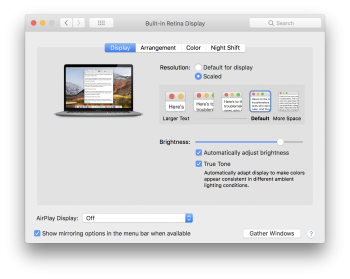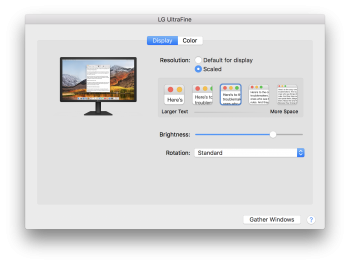I bought a new 2018 15" MBP and for the first time I'm dealing with the concept of "display scaling".

And on my new "LG UltraFine 4K Display":

So the point is, I get more screen "real estate" when selecting "more space" and more "per-pixel density" using "larger text".
But I'm not clear as to what this actually means. For instance, the "more space" setting for my 4k display says it "Looks like 2560 x 1440". But it's a "4096-by-2304" display! OK, so everything is upscaled by 60%? Here are the other factors:
4k Display
2560x1440: 1.6 upscale (aka "More Space")
2304x1296: 1.77 upscale
2048x1152: 2 upscale
1680x945: 2.44 upscale
1280x720: 3.2 upscale (aka "Larger Text")
15" MBP Display
1920x1200: 1.5 upscale (aka "More Space")
1680x1050: 1.71 upscale (aka "Default")
1440x900: 2 upscale
1280x800: 2.25 upscale
1024x768: 2.8 upscale (aka "Larger Text")
But in a strange way I've noticed that it's actually a bit less "fluid". Applications like VSCode (perhaps because it's an Electron app?) perform a bit differently (in terms of UI and font sizing) at the different resolutions. For example, VSCode doesn't let my screen go below 9px for a font (which is desirable when using the 2x scale (2048x1152) on a 4k display (trying to capture the sort of feel for an individual application as if it were running in a "More Space" format).
I've also seen mentions of battery life across the internet when using the MBP at a non-default scaling. But practically speaking, am I wasting the quality of the display my 15" MBP display if I set it's virtual resolution at "1920x1200"?
Does this impact how videos (Firefox showing a YouTube video for example) are actually rendered? I.e. do they see that my computer can / cannot handle a true 1080p video?

And on my new "LG UltraFine 4K Display":

So the point is, I get more screen "real estate" when selecting "more space" and more "per-pixel density" using "larger text".
But I'm not clear as to what this actually means. For instance, the "more space" setting for my 4k display says it "Looks like 2560 x 1440". But it's a "4096-by-2304" display! OK, so everything is upscaled by 60%? Here are the other factors:
4k Display
2560x1440: 1.6 upscale (aka "More Space")
2304x1296: 1.77 upscale
2048x1152: 2 upscale
1680x945: 2.44 upscale
1280x720: 3.2 upscale (aka "Larger Text")
15" MBP Display
1920x1200: 1.5 upscale (aka "More Space")
1680x1050: 1.71 upscale (aka "Default")
1440x900: 2 upscale
1280x800: 2.25 upscale
1024x768: 2.8 upscale (aka "Larger Text")
But in a strange way I've noticed that it's actually a bit less "fluid". Applications like VSCode (perhaps because it's an Electron app?) perform a bit differently (in terms of UI and font sizing) at the different resolutions. For example, VSCode doesn't let my screen go below 9px for a font (which is desirable when using the 2x scale (2048x1152) on a 4k display (trying to capture the sort of feel for an individual application as if it were running in a "More Space" format).
I've also seen mentions of battery life across the internet when using the MBP at a non-default scaling. But practically speaking, am I wasting the quality of the display my 15" MBP display if I set it's virtual resolution at "1920x1200"?
Does this impact how videos (Firefox showing a YouTube video for example) are actually rendered? I.e. do they see that my computer can / cannot handle a true 1080p video?

